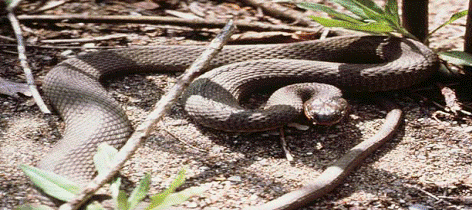‘Threatened’ no more: the Lake Erie watersnake’s road to recovery
This month, the Lake Erie watersnake (Nerodia sipedon insularum) was finally removed from the list of organisms protected under the Endangered Species Act. The achievement is a win for both the species and the ecosystem in which it plays a vital role.
With one of the smallest geographic ranges of any vertebrate in the world, this subspecies of snake is only found on the islands of Lake Erie, located in east-central North America. Primarily active between early May and October, depending on temperatures and weather conditions, these non-venomous reptiles spend the warmer months dwelling around the cliffs and rocky shorelines of the lake’s limestone islands. During winters, the snakes hibernate underground. Unlike other Nerodia subspecies, whose coloration varies, the Lake Erie watersnakes have a uniform gray coloring and grow from 1.5- to 3.5-feet long.
At the time of its initial listing, the species was threatened by intentional killing and loss of its natural habitat to shoreline development. However, roughly 300 acres of surrounding habitat and 11 miles of shoreline have been protected for the snake since it was first listed as “threatened” on August 30, 1999.
Shortly after its listing, the federal government began intensive monitoring efforts of the species, including public outreach programs to promote awareness of the snake and provide information on its important role in the local ecosystem. In September 2003, the U.S. Fish and Wildlife Service (FWS) finalized a recovery plan that called for protecting its remaining habitat and providing further outreach to reduce threats to the species. In cooperation with the Ohio Department of Natural Resources (ODNR) and other partners, biologists also worked to minimize threats to the snake through implementing conservation efforts.
Recovery criteria include a combined population of at least 5,555 snakes, sustained for six years, and protection of key habitat. Through this successful collaboration between government and the local community, the Lake Erie watersnake population grew to about 11,980 in 2009, and has exceeded the minimum recovery level since 2002. FWS first declared its intention to delist the snake in June 2010.
The perpetuation of the species has been critical to the Lake Erie region. During the 1990s, the round goby – an aggressive invasive fish that out-competes native fishes for food, shelter, and nesting sites – established itself in the Great Lakes and caused substantial declines of many native fish populations. These gobies have also been found to carry 25 species of parasites.
The predatory Lake Erie watersnakes have helped maintain balance in the ecosystem by keeping the population of invasive gobies in check. Today, 90 percent of the watersnake’s diet is round goby, with the remainder composed of mudpuppies and native fish. The invasive goby inadvertently played a pivotal role in the snake’s comeback by providing it with a tasty and abundant new menu item. Conversely, the snake also serves as prey for herons, hawks, and eagles, furthering its importance to the region.
The Endangered Species Act mandates that any de-listed species should continue to be monitored for at least five years to ensure the population is self-sustaining. This particular species also is still listed as endangered at the state level in Ohio, so it remains illegal to kill the snake within state borders.
For more information on the Lake Erie watersnake as well as FWS’s recovery monitoring efforts, see: http://www.fws.gov/midwest/endangered/reptiles/lews/index.html
Photo Credit: Dr. Richard King, FWS
